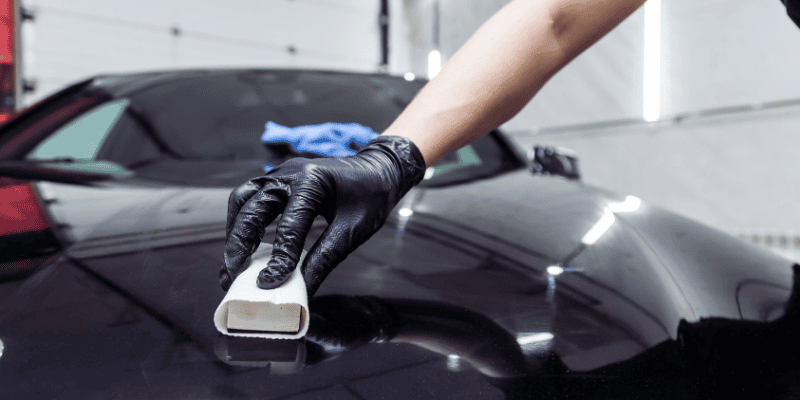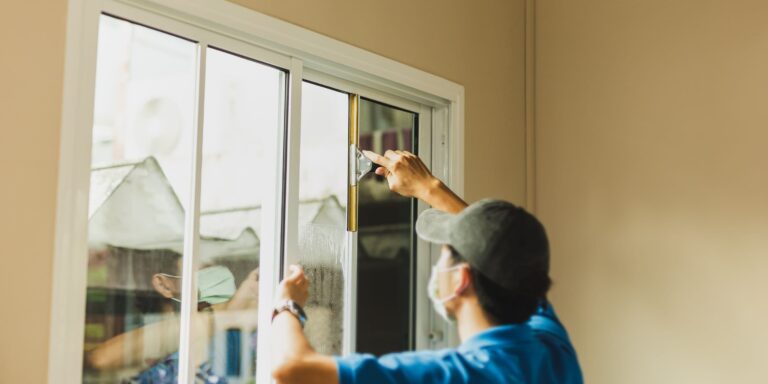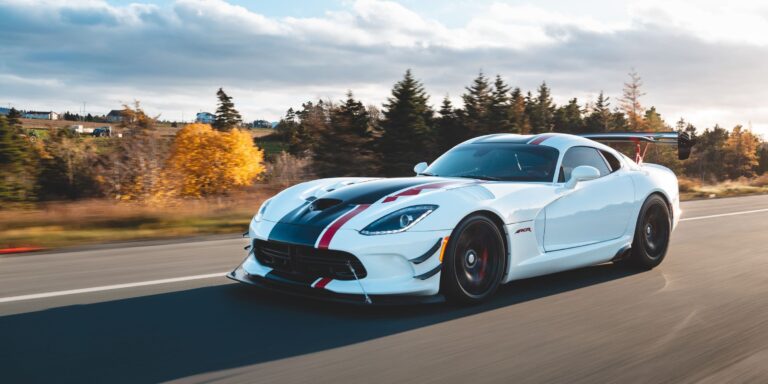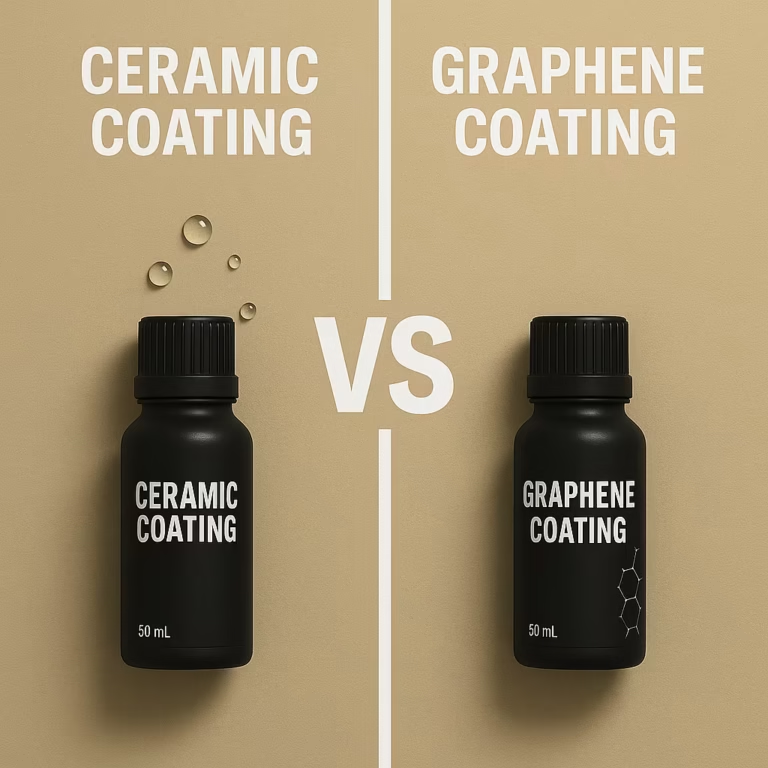You wash your car on a weekend, step back, and admire that mirror-like shine. It looks flawless until, a few days later, dust, sun glare, and water spots ruin the finish again. The paint begins to lose its glow, and that frustration kicks in: “Why doesn’t it stay clean or shiny for long?” It’s a problem every car owner faces: spending hours maintaining their car only to see the shine fade faster than expected.
The truth is, your car’s paint goes through a lot every single day, harsh sunlight, bird droppings, acid rain, and road debris slowly damage the clear coat. That’s why choosing the right layer of protection isn’t just about looks; it’s about saving your car’s paint from early aging. And this is where the big question arises: Should you go with ceramic coating or stick to traditional wax?
Both promise a glossy finish and protection, but the way they work and how long they last, are worlds apart. In this guide, you’ll learn the key differences between ceramic coating and wax, their pros and cons, and the honest truth about which one gives your car lasting shine and protection without wasting your time or money.
What is Car Wax?
Car wax is the traditional choice for protecting car paint. It dates back decades and has been a staple for car enthusiasts who love that deep, warm glow. Most waxes use natural ingredients like carnauba wax from palm leaves, mixed with synthetic additives to improve durability. Wax forms a protective layer on top of the paint, shielding it from UV rays, rain, and dirt.
However, wax does not bond chemically with your paint. Instead, it sits on top as a sacrificial layer that wears off over time due to washing, heat, or harsh weather.
Types of car wax include:
- Carnauba Wax: Gives a warm, deep shine but lasts shorter (around 6–8 weeks).
- Synthetic Wax (Paint Sealant): Offers longer protection (up to 4–6 months).
- Spray Wax: Easy to apply for quick shine but fades quickly.
- Liquid and Paste Wax: Ideal for regular maintenance with better coverage.
Car wax remains a favorite for those who want quick results, a brilliant glow, and easy application without complex preparation.
What is Ceramic Coating?
Ceramic coating is an advanced paint protection solution made from silicon dioxide (SiO₂) or similar compounds that create a strong chemical bond with the vehicle’s clear coat. Once applied, it hardens into a transparent, glass-like layer that offers long-lasting protection. Unlike wax, which sits on top, ceramic coating becomes part of the paint surface, providing years of durability instead of weeks or months.
Ceramic coatings protect against:
- UV rays that cause oxidation and fading
- Acidic contaminants like bird droppings and bug splatter
- Chemical stains from road salts and pollution
- Light scratches and swirl marks
- Water spots, thanks to its hydrophobic (water-repelling) properties
You can find DIY spray ceramics for light use or professional-grade coatings that last 3–5 years or more. The result is a glossy, “wet” finish that resists grime, meaning your car stays cleaner longer.
Other Alternatives and Hybrid Options
Between wax and ceramic coatings lies a middle ground, paint sealants and hybrid coatings. Paint sealants are synthetic products that last longer than traditional wax but are easier to apply than full ceramics. Some hybrid products combine ceramic polymers with wax to give you both durability and shine.
There are also graphene coatings, an upgrade from ceramic technology, which claim better heat resistance and smoother surfaces. These options are growing popular for drivers who want strong protection without spending on professional ceramic coating installation.
| Type | Durability | Shine | Cost | Ease of Use |
| Carnauba Wax | 1–2 months | Warm, deep | Low | Very easy |
| Synthetic Sealant | 4–6 months | Glossy | Moderate | Easy |
| Ceramic Coating | 2–5 years | Glass-like | High | Requires skill |
| Hybrid Wax-Ceramic | 6–12 months | Enhanced gloss | Medium | Easy |
| Graphene Coating | 5+ years | Deep gloss | Very high | Professional |
Each option serves a purpose, wax for simplicity and short-term shine, and ceramic coatings for long-term protection and reduced maintenance.
Core Comparison: Ceramic Coating vs Wax
Now that we’ve defined both, let’s compare how they perform in real conditions. This comparison is based on major factors such as durability, protection, gloss, maintenance, and cost.
Durability and Longevity
Wax lasts for weeks or a few months, depending on exposure and quality. It gradually wears off with every wash, especially if the car is parked under the sun or driven often. Ceramic coatings, on the other hand, last years, often between 2 to 5 years, and some professional coatings can last even longer. They bond with the paint, making them resistant to rain, chemicals, and UV rays.
If you want low maintenance and longer-lasting protection, ceramic coating clearly wins in this category.
Level of Protection
Protection is where ceramic coating shines the most. It can handle acidic contaminants, oxidation, and UV degradation far better than wax. Wax gives decent defense against rain and sunlight but offers little chemical resistance. A ceramic-coated car stays cleaner for longer since dirt, mud, and water don’t stick as easily.
In summary:
- Wax protects against basic weather and UV exposure.
- Ceramic coating protects against environmental hazards, chemicals, and oxidation more effectively.
Gloss and Shine
This is where wax continues to have its fans. Wax delivers that deep, warm glow that makes colors pop, especially darker paints. Ceramic coating, in contrast, produces a mirror-like gloss that reflects light sharply and enhances the paint’s clarity.
Both look stunning, but the appearance differs:
- Wax = softer, deeper glow
- Ceramic coating = crisp, glassy reflection
The choice depends on your personal preference for finish style.
Maintenance and Cleaning
Wax requires regular reapplication. Frequent washing and exposure to rain can remove it quickly. Ceramic coatings are hydrophobic, meaning water and dirt slide off easily. You can wash your car less often, and it stays clean longer.
However, maintaining ceramic coatings requires careful washing using pH-neutral shampoos and avoiding abrasive cloths. If maintained properly, it stays glossy for years without needing reapplication.
Cost, Time, and Effort
Wax is affordable, usually costing $10–$50 per application, and can be applied in under an hour. Ceramic coatings range from $50 for DIY kits to $1,000+ for professional services. Application is time-consuming requiring paint correction, surface preparation, and curing.
But while ceramic coating costs more upfront, it saves you money in the long run because it lasts longer and reduces the need for frequent detailing.
Risks and Drawbacks
No product is perfect.
Wax drawbacks:
- Melts under extreme heat
- Short protection time
- Requires frequent maintenance
Ceramic coating drawbacks:
- Expensive and time-intensive to apply
- Mistakes (like high spots or uneven application) can be hard to fix
- Professional help may be needed
Choosing depends on your budget, how often you can maintain your car, and how long you plan to keep it looking new.
How to Apply and Maintain Each Option
Protecting your car’s paint isn’t just about choosing the right product, it’s also about applying it correctly. A poor application can ruin the finish, no matter how high-quality your wax or coating is. Below is a detailed guide on how to apply both wax and ceramic coating properly, along with maintenance tips to keep your car shining longer.
Step-by-Step: Wax Application and Maintenance
Waxing is simple and doesn’t require expensive equipment. But to get that deep, flawless shine, preparation is key.
Steps to apply wax:
- Wash the car thoroughly: Use a gentle car shampoo to remove dirt and grime.
- Dry completely: Water spots can prevent wax from bonding evenly.
- Use a clay bar (optional): This removes contaminants stuck in the paint for a smoother surface.
- Apply wax in small sections: Use a soft foam or microfiber applicator and apply a thin, even coat.
- Let it haze: Most waxes need a few minutes to dry before buffing.
- Buff off gently: Use a clean microfiber cloth to remove residue and bring out the shine.
Maintenance tips:
- Avoid washing for 24 hours after waxing.
- Use quick detailer sprays to refresh gloss between waxes.
- Reapply every 6–8 weeks for consistent protection.
Waxing doesn’t require professional help, but regular maintenance is crucial for continuous shine and protection.
Step-by-Step: Ceramic Coating Application and Maintenance
Applying ceramic coating demands more time and attention. It’s not just spreading a layer; it’s a bonding process. A small mistake can lead to uneven results, so preparation is everything.
Steps to apply ceramic coating:
- Wash the car carefully: Remove all dust, dirt, and oils.
- Decontaminate the surface: Use an iron remover and clay bar to get rid of embedded particles.
- Paint correction: If your paint has swirl marks or scratches, polish it first, ceramic coating locks in whatever is underneath.
- Use isopropyl alcohol (IPA) wipe: This removes any leftover polish residue and ensures a clean bonding surface.
- Apply coating panel by panel: Use a soft applicator cloth and apply cross-hatch patterns (up-down, side-to-side).
- Let it flash: Wait until it begins to haze slightly, then buff it off with a clean microfiber towel.
- Allow curing: Keep the car indoors and dry for at least 24–48 hours.
Maintenance tips:
- Use pH-neutral car shampoo to avoid damaging the coating.
- Avoid automatic car washes.
- Use ceramic boosters every few months to maintain hydrophobic properties.
- Never dry wipe your coated car, always use a microfiber cloth and quick detailer if needed.
Ceramic coating takes more time but provides exceptional long-term protection if applied and maintained correctly.
Common Mistakes and Troubleshooting
Even careful users make mistakes while applying these products. Knowing the common issues can help you avoid costly errors.
For wax:
- Applying it too thickly makes buffing harder and can leave streaks.
- Waxing under direct sunlight causes premature drying and patchy coverage.
- Skipping paint prep, dirt or contaminants can get trapped under the wax.
For ceramic coating:
- Applying too much product leads to “high spots” or rainbow patches.
- Not allowing enough curing time, reduces the coating’s bonding strength.
- Ignoring surface prep, the coating can seal in defects like swirl marks.
Tip: Always test in a small section before doing the full car.
FAQs
How long does ceramic coating last?
Ceramic coating typically lasts 2 to 5 years for high-quality professional applications, while DIY versions may last around 12–18 months. Longevity depends on maintenance and environmental exposure.
How often should I wax my car?
Wax should be reapplied every 6–8 weeks for consistent protection. Harsh weather or frequent washing may require more frequent applications.
Is ceramic coating worth the price?
Yes, if you plan to keep your car for several years. It saves time on washing, enhances resale value, and provides strong protection against environmental damage. While it’s expensive upfront, it reduces long-term maintenance costs.
Does ceramic coating prevent scratches?
Ceramic coatings are scratch-resistant, not scratch-proof. They help prevent minor swirl marks and micro-scratches from washing, but sharp objects or debris can still scratch the paint.
Is wax better for classic cars?
For classic or garage-kept cars, wax is often better. It gives a natural shine and is easy to remove or reapply without affecting the paint. Ceramic coating might be unnecessary unless the car is driven frequently.
Choosing What’s Right for You
Now that you understand both products and their maintenance, let’s decide which is best for your situation. The right choice depends on your car type, environment, and budget.
Your Driving and Parking Conditions
If your car is parked outdoors most of the time or exposed to harsh sun, bird droppings, and pollution, ceramic coating is ideal. For garage-kept vehicles or occasional drivers, wax provides adequate protection and shine at a lower cost.
Time and Skill Level
If you enjoy DIY car care and like frequent touch-ups, wax is easy to apply and forgiving. But if you prefer low maintenance and long-term protection, ceramic coating will save you effort , even if it requires professional help initially.
Budget and Long-Term Value
Here’s a quick comparison of cost versus lifespan:
| Product Type | Average Cost | Lifespan | Maintenance Level |
| Carnauba Wax | $10–$50 | 1–2 months | High |
| Synthetic Sealant | $30–$80 | 4–6 months | Moderate |
| Ceramic Coating (DIY) | $70–$200 | 1–2 years | Low |
| Ceramic Coating (Pro) | $800–$1,500 | 3–5 years | Very Low |
Wax costs less upfront but adds up over time with frequent reapplications. Ceramic coating costs more initially but offers a much better return in protection and durability.
Aesthetic Preferences
If you love that classic, soft, deep shine, wax is unmatched. But if you prefer a crystal-clear, reflective look that turns heads in daylight, ceramic coating will deliver that modern glossy finish.
Hybrid and Combined Protection Strategy
Some detailers recommend using both: ceramic coating for the foundation and a light wax layer on top for added gloss. This combination enhances shine without compromising the coating underneath.
However, if you do this, make sure the wax you use is ceramic-safe, free from harsh abrasives or cleaners that can weaken the coating.
Conclusion: The Clear Winner Between Ceramic Coating and Wax
Choosing between ceramic coating and car wax depends on your goals, budget, and how much time you want to invest in maintaining your car’s shine. If you want long-lasting protection, a glossy finish that stays for years, and strong resistance to scratches, UV rays, and chemicals, ceramic coating is the better choice. It might cost more initially, but its durability and ease of maintenance make it a smart long-term investment.
On the other hand, if you enjoy detailing your car regularly and prefer a cheaper, short-term option for adding quick shine and water beading, car wax works well. It’s simple to apply and gives a warm, classic glow that many car lovers still appreciate.
To put it simply:
- Choose ceramic coating if you want protection and shine that last for years.
- Choose wax if you prefer a quick, affordable, and temporary gloss.
Either way, both products improve your car’s appearance and help preserve its paint. The best choice depends on how much effort and budget you’re willing to dedicate to keeping your car looking fresh and well-protected.




